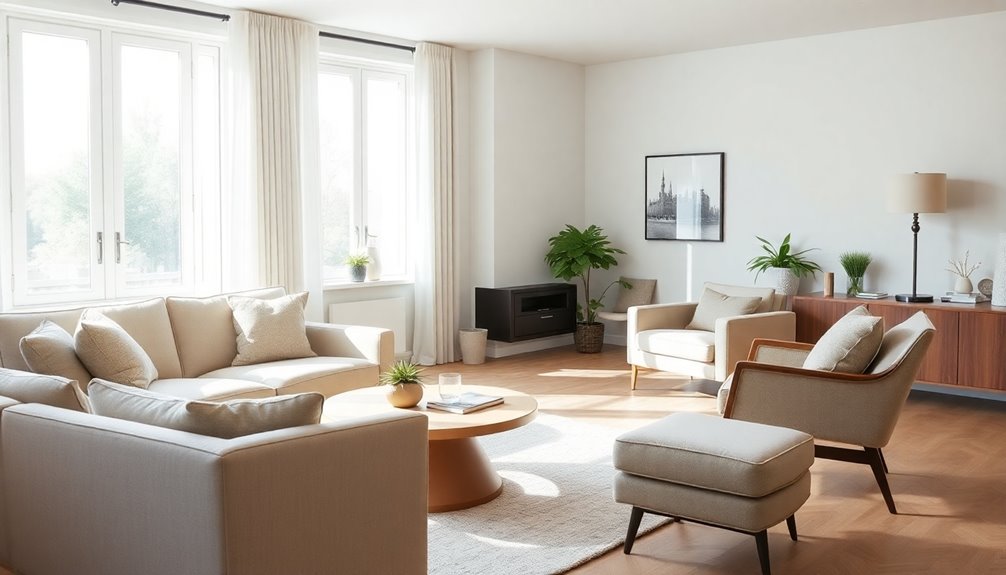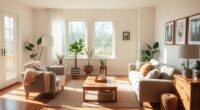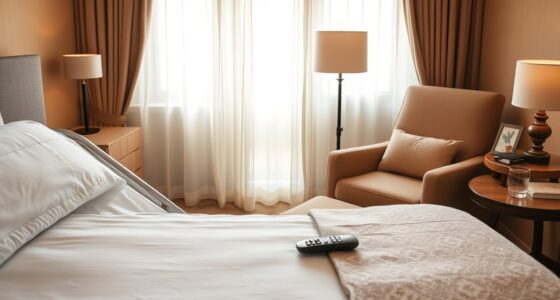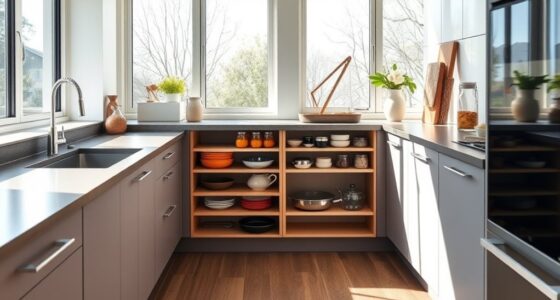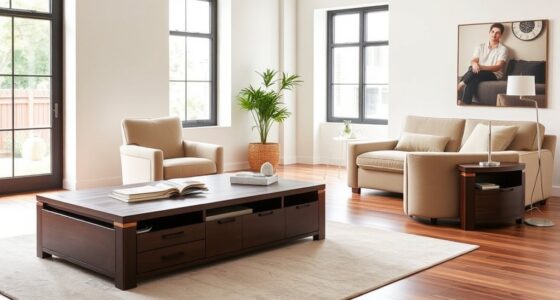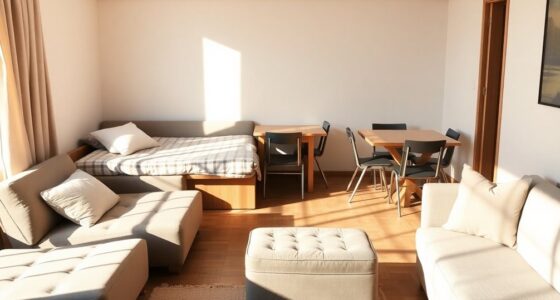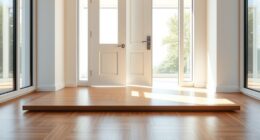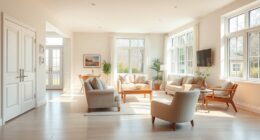To create chic furniture layouts that simplify aging in place, focus on open spaces and clear pathways for easy navigation. Choose accessible seating with high arms and firm cushions, and incorporate multi-functional furniture to maximize usability. Utilize corner spaces for storage and add flexible arrangements for social interaction. Don't forget about lighting; smart systems and layered fixtures enhance safety and ambiance. Continue exploring to discover more stylish and practical ideas that enhance comfort and functionality in your home.
Key Takeaways
- Create open space layouts with 5 ft x 5 ft clear areas for mobility aids and turning, ensuring safety and accessibility.
- Opt for seating arrangements with firm cushions and high arms that enhance comfort and support for easy movement.
- Utilize multi-functional furniture like sofa beds and adjustable tables to maximize space while accommodating various activities.
- Ensure well-lit pathways using automated lighting systems and multiple light sources to reduce fall risks and enhance visibility.
- Incorporate personalized storage solutions such as wall-mounted shelves and corner units to keep the space organized and clutter-free.
Open Space Design for Easy Navigation
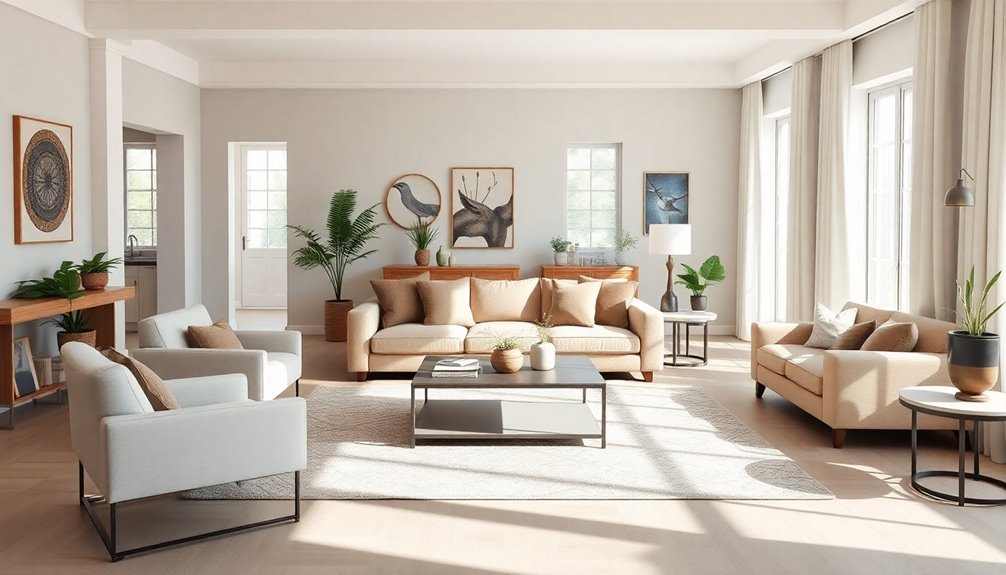
When you embrace open space design, you create an environment that enhances navigation for seniors. This layout offers a minimum 5 ft x 5 ft clear area, essential for mobility aids like walkers and wheelchairs.
By eliminating cluttered pathways, you help reduce the risk of falls, allowing for safer movement throughout the space. Strategically placing furniture guarantees unobstructed access to key areas, fostering independence in daily activities.
Keeping furniture away from walls creates a more comfortable flow and easier access to light switches and controls. Plus, integrating multi-functional furniture maximizes usability while maintaining a safe and inviting environment.
Accessible Seating Arrangements
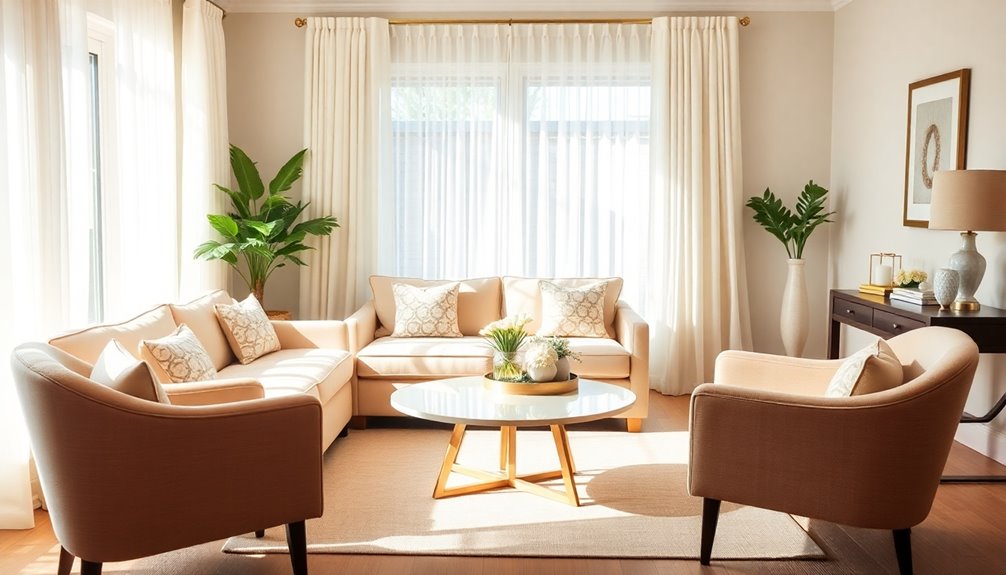
Creating accessible seating arrangements is essential for guaranteeing comfort and safety for seniors. By prioritizing ease of access, you can help maintain independence while minimizing tripping hazards.
Here are some key points to take into account:
- Choose chairs and couches with solid grips to prevent shifting.
- Select seating with a height of 17-19 inches and high arms for easier shifts.
- Confirm at least 30 inches of space in front of seating areas for mobility aids.
Avoid overly soft cushions that may hinder mobility; instead, opt for firmer options that provide adequate support. Additionally, contemplate lift chairs for those needing extra assistance when standing up, greatly reducing the risk of falls during transfers. Incorporating natural elements like wood or stone in the design can also create a soothing environment that promotes relaxation and comfort.
Multi-Functional Furniture Solutions

When it comes to aging in place, multi-functional furniture solutions can make a big difference in your daily life. Space-saving designs, adaptive seating options, and convertible tables not only enhance comfort but also improve accessibility. Additionally, implementing budgeting techniques can help manage the costs associated with purchasing such versatile furniture. Moreover, investing in ergonomic furniture for senior comfort can significantly reduce the risk of strain and injury, making daily activities much easier to navigate. These specially designed pieces not only provide optimal support but also encourage mobility and independence, allowing seniors to maintain their lifestyle in a familiar environment. By carefully selecting furniture that meets both functional and aesthetic needs, you can create a home that promotes well-being and enhances the aging in place experience.
Space-Saving Design Options
As you reflect on space-saving design options for aging in place, multi-functional furniture can be a game changer.
These versatile pieces not only enhance functionality but also improve accessibility, ensuring your living space remains safe and inviting.
Here are some great options to explore:
- Sofa beds provide extra sleeping arrangements without sacrificing space.
- Adjustable height tables can serve as dining, hobby, or workspace areas, accommodating mobility aids.
- Nesting tables can be stored away easily, helping to maintain clear pathways and minimize tripping hazards.
Incorporating durable materials in your furniture selection can further enhance safety and longevity, making your living space even more suitable for aging in place.
Adaptive Seating Solutions
How can you guarantee comfort and safety in your living space? Consider integrating adaptive seating solutions that cater to seniors aging with mobility challenges.
Lift chairs are perfect for providing assistance when switching between sitting and standing, ensuring independence. Look for chairs with high arms and firm cushions, as they facilitate easier movement and reduce strain.
Multi-functional furniture, like sleeper sofas or storage ottomans, maximizes your space while offering practical uses. Incorporate pieces with rounded edges to minimize injury risks from falls.
Also, adjustable seating options with varying heights can accommodate changing mobility needs, ensuring continued comfort and usability over time. Additionally, integrating best home security systems can enhance safety and provide peace of mind for both seniors and their families.
Convertible Table Features
Convertible tables are a game-changer for seniors looking to maximize their living space.
These versatile pieces not only adapt to various needs but also enhance safety and accessibility. With features designed to support your lifestyle, you can easily maintain your independence.
- Flexible Size: Drop-leaf and extendable models adjust for dining, crafts, or activities.
- Safety First: Rounded edges reduce injury risks, ensuring a safer environment.
- Built-in Storage: Keep clutter at bay while maintaining clear pathways for mobility aids.
In addition, regular maintenance of mechanical components ensures these tables function smoothly and safely.
Whether you need an adjustable height table or a stylish solution, convertible tables can transform your space into a functional and inviting home.
Embrace the freedom they offer in aging in place!
Clear Pathways to Enhance Mobility
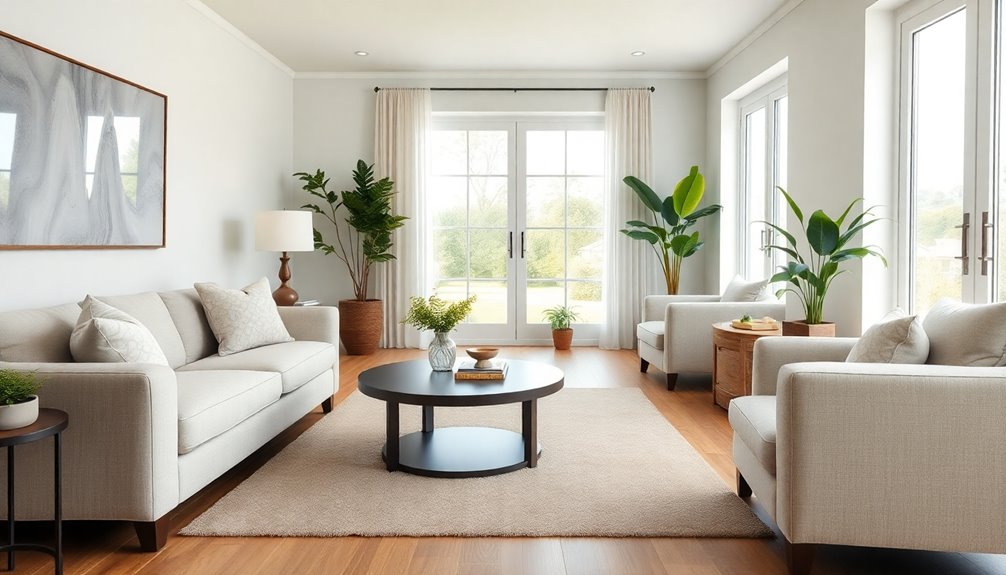
Creating clear pathways is essential for enhancing mobility in a home designed for aging in place. To optimize safety, guarantee at least 5 ft x 5 ft of space for turning around and maintain 30 in x 48 in of clear space in front of appliances. This setup promotes easy navigation and helps prevent falls. Regularly assess the layout to keep pathways unobstructed for mobility aids like walkers and wheelchairs. Additionally, arrange seating to create smooth routes and minimize obstacles.
| Space Requirement | Purpose | Safety Tips |
|---|---|---|
| 5 ft x 5 ft | Turning around | Keep pathways clear |
| 30 in x 48 in | Access to appliances | Avoid clutter |
| Clear pathways | Enhance mobility | Use rounded edges |
| Regular assessment | Prevent falls | Check for obstacles |
Utilizing Corner Spaces Effectively
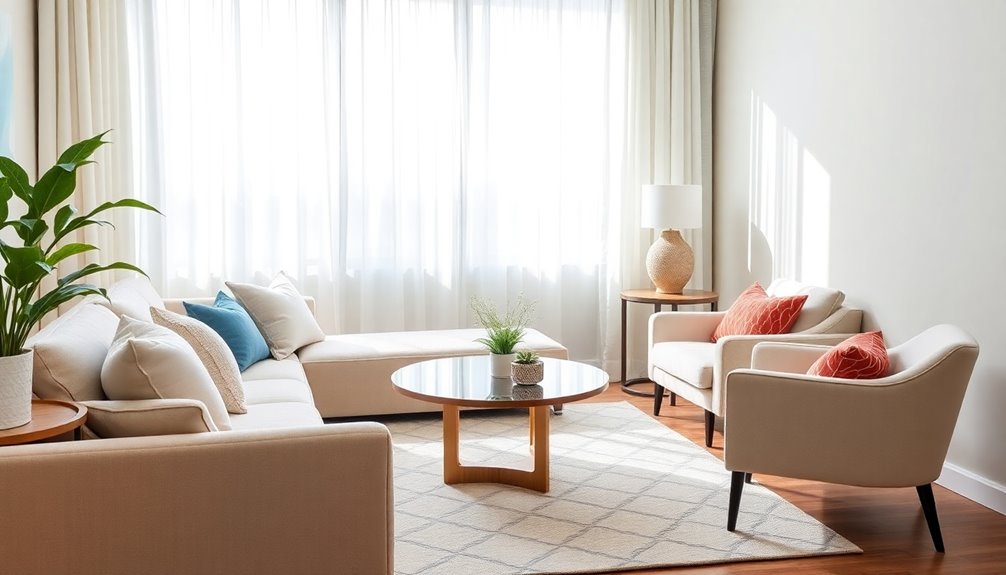
You can transform corner spaces into functional areas that enhance both comfort and accessibility.
By optimizing seating arrangements and incorporating smart storage solutions, you'll create an inviting environment that supports your needs.
Let's explore how to make the most of these often-overlooked spots in your home.
Optimize Seating Arrangements
Utilizing corner spaces effectively can transform underused areas into inviting seating nooks that promote comfort and accessibility for seniors.
To optimize seating arrangements, consider these tips to make it easier for seniors to navigate their living spaces:
- Use rounded furniture to minimize sharp edges, reducing fall risks in tight corners.
- Guarantee at least 30 inches of clear space in front of seating for wheelchair or walker access.
- Incorporate adjustable height furniture, like lift chairs, to accommodate varying mobility needs.
Regular maintenance and fire safety regulations are also important when placing furniture around heat sources like wood stoves.
Enhance Accessibility Options
Transforming corner spaces into accessible areas can greatly improve seniors' comfort and mobility at home.
To enhance accessibility options, consider adding accessible seating with rounded edges and lift chairs to minimize fall risks. Utilizing corner shelving and wall-mounted storage can free up floor space, making pathways wider and safer for mobility aids.
An adjustable-height corner table allows easy access to drinks, snacks, or daily activities without stretching across the room. Additionally, installing grab bars in these areas provides essential support when moving from sitting to standing, boosting safety and confidence.
Finally, well-placed corner lighting, like floor or table lamps, guarantees visibility, reducing accident risks and making these spaces more inviting and functional. Incorporating smart home devices can further enhance safety by allowing seniors to control lighting and appliances effortlessly, ensuring they remain independent and comfortable.
Incorporate Storage Solutions
Corner spaces offer a unique opportunity to maximize storage and enhance the functionality of your home. By strategically incorporating storage solutions, you can keep frequently used items easily accessible while maintaining a clutter-free environment.
Here are some effective ideas:
- Install corner shelving units or cabinets to utilize vertical space.
- Use lightweight bins or baskets for quick access to essentials without obstructing pathways.
- Add built-in corner benches for seating that also provides storage for blankets or magazines.
These solutions not only enhance your living space but also help reduce tripping hazards. Regularly decluttering these areas guarantees safety and comfort, making your home a welcoming environment for everyone, especially seniors. Additionally, mindful decluttering can create a more organized and serene living space, further promoting ease of movement and accessibility.
Integrating Technology for Convenience

As you embrace the concept of aging in place, integrating technology can greatly enhance your daily life and promote independence.
Smart technology allows you to control lights, door locks, and appliances easily through voice commands or mobile apps, making it convenient and safe.
Automated lighting systems with timers or motion sensors guarantee well-lit paths at night, reducing the risk of falls.
Virtual home assistants, like Amazon Echo or Google Home, simplify daily tasks such as setting reminders or making hands-free calls, supporting senior-friendly living.
Additionally, adaptive technology solutions help notify hearing-impaired individuals of important sounds, improving safety.
With simplified interfaces like big button remotes, operating devices becomes effortless, allowing you to enjoy your space with confidence. Moreover, ensuring a safe sleep environment for aging individuals can further enhance their comfort and well-being during rest.
Flexible Layouts for Social Interaction
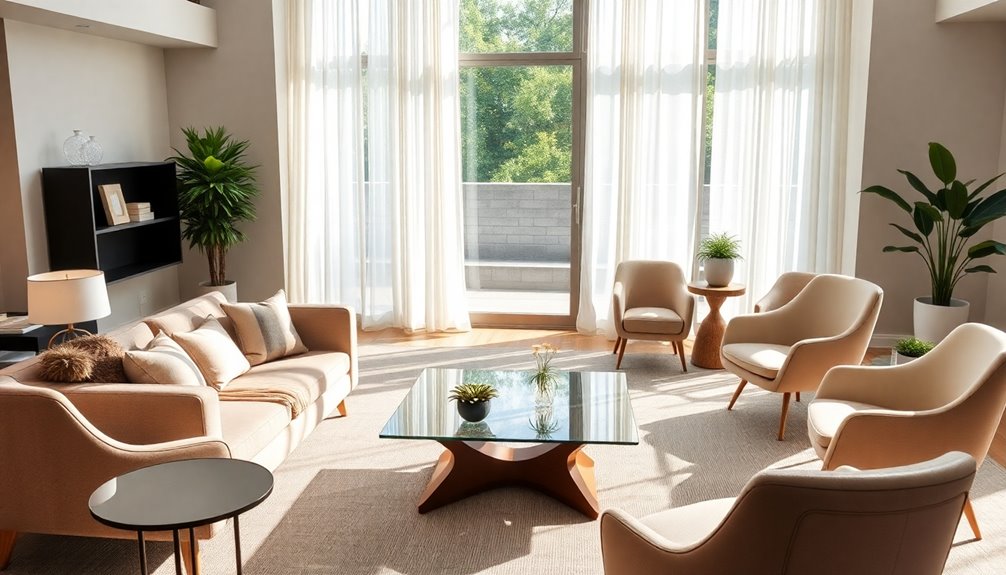
To create an inviting space for social interaction, arrange your seating in a U or L shape to encourage group conversations.
Make sure to maintain clear pathways around furniture, allowing easy navigation for all guests.
Encourage Group Conversations
Creating a space that promotes group conversations can greatly enhance social interactions, especially for seniors. By thoughtfully arranging seating, you foster an inclusive social environment.
Consider these key elements:
- Circular or semi-circular layouts: They enhance visibility and facilitate communication among group members.
- Seating within arm's reach: This minimizes strain and supports comfortable interactions, making it easier to engage in conversation.
- Clear pathways: Make certain all guests can navigate the space without obstacles, which is vital for those with mobility challenges.
Incorporating lightweight furniture allows for easy rearrangement, accommodating various group sizes.
Adding small side or coffee tables encourages shared activities, fostering a sense of community. A well-designed layout not only promotes connection but also makes everyone feel included. Additionally, creating spaces that are accessible and inclusive can reflect the principles of safety regulations established for public venues.
Optimize Seating Arrangements
Encouraging group conversations sets the stage for optimizing seating arrangements that enhance social interaction.
Arrange seating in a circular or U-shape to guarantee everyone can easily interact without straining to hear. Choose chairs and sofas with sturdy arms, making it easier for seniors to stand up or sit down, which promotes independence and reduces fall risk.
Keep all seats within reach of coffee tables or side tables to minimize stretching and bending, addressing mobility challenges. Incorporate lightweight, movable furniture for flexible arrangements, allowing you to adapt based on the gathering's needs.
Finally, maintain a minimum of 36 inches of clear walkway space between furniture pieces—an effective way to make navigation safe and welcoming for guests.
Clear Pathways for Guests
Clear pathways are essential for ensuring guests feel welcome and can navigate your space with ease.
By creating open pathways of at least 5 feet wide, you enhance accessibility for those using mobility aids, reducing the risk of accidents.
Here are a few tips to reflect upon:
- Keep pathways clear of obstacles and clutter to foster a safe environment.
- Arrange seating areas near common spaces, encouraging social interaction and reducing feelings of isolation.
- Use flexible furniture arrangements, allowing for easy reconfiguration to suit larger gatherings or intimate chats.
Safe and Stylish Storage Options
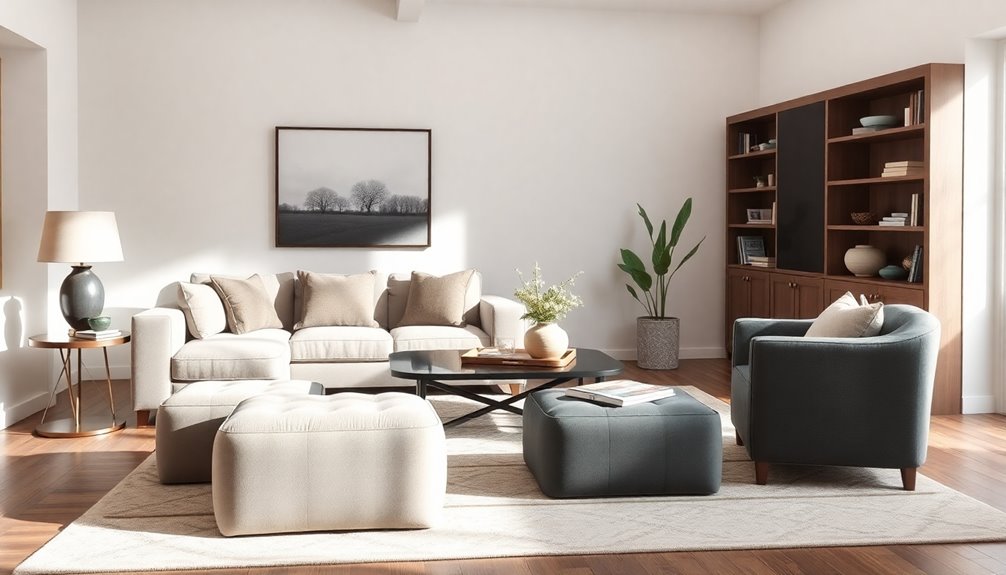
While you're designing a space that prioritizes safety for seniors, stylish storage options can play an essential role in maintaining both independence and elegance.
Opt for lower shelving units and cabinets to guarantee everything's within easy reach, reducing the risk of falls. Clear labeling on bins and shelves makes it easier for seniors to identify and grab what they need without straining.
Incorporating baskets or bins helps keep frequently used items organized and accessible, while wall-mounted shelves free up floor space, reducing clutter.
Regularly decluttering storage areas allows you to maintain a tidy environment, promoting safety.
Lighting Strategies for Safety and Ambiance
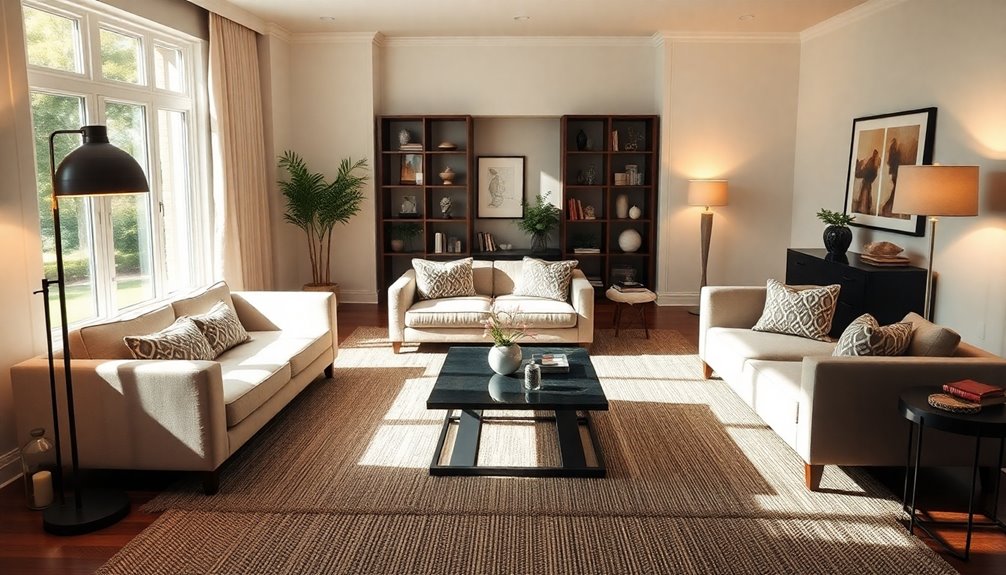
Creating a safe and stylish environment for seniors goes beyond storage solutions; lighting plays an essential role in enhancing both safety and ambiance in the home.
Effective lighting strategies can considerably improve quality of life by addressing specific needs. Here are some tips to take into account:
- Use multiple light sources, including floor and table lamps, to brighten the living room.
- Incorporate task lighting in areas for reading or crafting to reduce eye strain.
- Opt for LED bulbs for energy efficiency and to lift mood in dim spaces.
Additionally, installing timers and remote-controlled lighting systems makes it easy for seniors to manage their environment, ensuring well-lit spaces and enhancing safety, especially during evening hours.
Personalizing Space Without Clutter
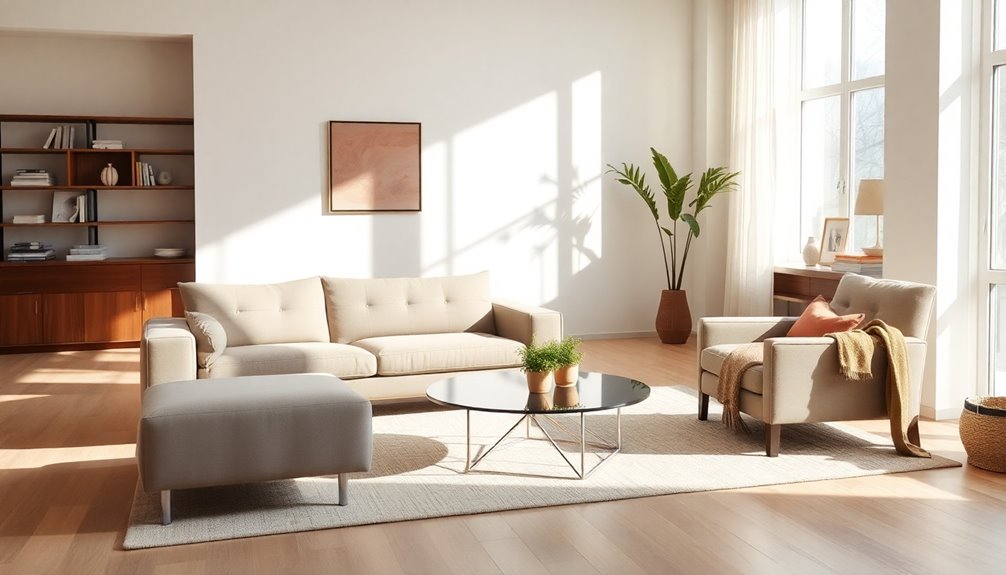
To personalize your space without overwhelming it, focus on incorporating lightweight decorative items that can easily be moved or adjusted.
Wall-mounted shelves are a great way to display your favorite memorabilia, keeping cherished items within reach while freeing up floor space.
Choosing furniture with built-in storage, like ottomans or coffee tables with compartments, helps you store items neatly and maintain an organized appearance.
Limit your decorative elements to a few key pieces that resonate personally, ensuring they don't obstruct pathways or create tripping hazards.
Regularly assess and rotate personal items to keep your space feeling fresh.
This approach not only enhances your living area but also helps caregivers make daily routines safer and more enjoyable.
Frequently Asked Questions
What Is the Best Home Design for Aging in Place?
The best home design for aging in place prioritizes safety, accessibility, and comfort.
You'll want an open floor plan that allows easy navigation and clear pathways of at least 36 inches wide.
Arrange furniture to eliminate tripping hazards, and guarantee there's a minimum 5 x 5 ft space for mobility aids.
Choose appropriate seating, like lift chairs, and opt for low-pile carpeting or solid surfaces to enhance safety and mobility throughout your home.
What Is the Best Seating for Seniors?
When choosing the best seating for seniors, aim for chairs with a height of 17-19 inches to ease changes.
Look for lift chairs that support their weight and provide comfort.
Opt for chairs with sturdy armrests and high backs, allowing for safe push-offs when standing.
Avoid overly soft cushions, as they can make getting up challenging.
Finally, choose furniture with rounded edges to minimize injury risks in case of falls.
What Is a Universal Design for Aging in Place?
Universal design for aging in place creates spaces that are accessible for everyone, regardless of age or ability.
It focuses on features like wider doorways, step-free entries, and easy-to-use appliances, making daily life simpler.
You'll appreciate the flexibility and intuitiveness these designs provide.
How to Arrange Furniture for the Elderly?
Imagine traversing your home with ease.
To arrange furniture for the elderly, create a spacious, clutter-free environment. Aim for a minimum 5 ft x 5 ft clear area for mobility aids and guarantee pathways are at least 36 inches wide.
Choose straight-legged furniture to reduce tripping hazards and place seating with high arms at a height of 17-19 inches.
Keep decorative elements minimal, allowing for effortless movement and safety throughout the space.
Conclusion
Incorporating these chic furniture layouts not only boosts beauty but also builds a barrier-free environment, making aging in place a breeze. By prioritizing accessibility and adaptability, you're paving the way for a safe, stylish sanctuary. So, embrace these elegant elements and let your living space shine with seamless simplicity. Remember, a thoughtfully designed home harmonizes health and happiness, ensuring you can thrive gracefully in your golden years. Choose comfort, creativity, and connection in every corner!
